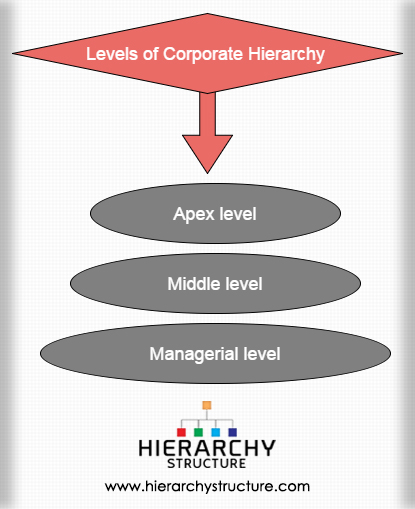Any corporation working in any field requires a proper management hierarchy if it wants to function efficiently. A proper management hierarchy is one wherein everyone is subordinate to the one at top thereby making each one responsible and answerable to someone for their actions. Not only should there be a proper allocation of duties but also the presence of a specified power structure that defines functions and duties of each employee. This not only ensures that there is an optimum utilization of resources but also helps in smooth functioning and proper execution of operations in the organization. A proper hierarchy is therefore necessary for the continued development of every corporation.

Generally, any company would have three basic hierarchy divisions depending upon the type of business and the structure it follows.
Apex level
At the top level are the people of who are responsible for major planning and setting up of corporate goals. These involve people like the CEO (chief executive officer), the President, the CFO (Chief financial officer) and the board of directors. They are the face of the company responsible for the company’s overall output to its shareholders and take all major decisions regarding its functioning and future policies. A part of the highest level in the business management hierarchy these people are also responsible for the overall controlling and backups in the organization.
Middle level
This level of management has positions like that of general managers, branch managers, department heads, etc. Responsible to the top management for the functioning of the managerial staff and overall functioning of the organization at the base root level, these people act as an active link between the staff at the ground level and the heads at the apex level. Management hierarchy at this level have functions relating to organizing, staffing and execution of goals set by the top level.
They work as the backbone of any corporation and are responsible for major designing and implementing of policies, monitoring and guiding of lower levels, diagnosing and resolving problems and coordination of the company’s functioning as a whole.
Managerial level
This is the lowest level of hierarchy in any corporation. Apart from doing the ground level execution of functions they also perform all menial jobs of the organization. These include people like section leads, supervisors, assistant managers and foremen. They don’t have any major decision making power and are only responsible for all tasks given to them by the other people standing higher in the hierarchy. Even though working at the lowest level of the management, they still have an integral part in the company’s functioning as they form the base level of the organization and therefore directly affect how the work is performed.
Such divisional levels of hierarchy are visible in all successful organizations since this is a must for all. Such a structure ensures that the management is at the peak of its efficiency level and there is no confusion among the employees thereby improving the overall functioning of the organization and ensuring its long term success.
